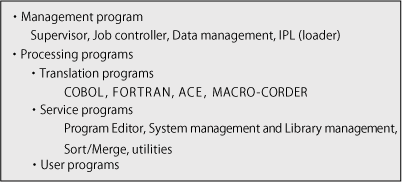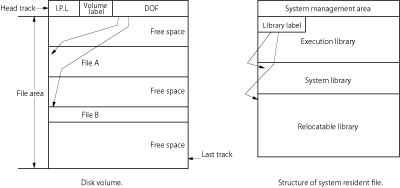MARK-III was a disk operating system developed for models 20 and 40 of Mitsubishi Electric's MELCOM-3100 announced in 1968. The operating system series also included MARK-I for Model 20T as the successor to Models 10T and 10PT operating systems, and MARK-II for Model 40 as the successor to Model 30T operating system.
MARK-III FOS (Fundamental Operating System) was configured as follows:

- Home >
- Historical Computers in Japan >
- Mainframe OS >
- Disk Operating System MARK-III for MELCOM-3100
【Mitsubishi Electric】 Disk Operating System MARK-III for MELCOM-3100

MARK III FOS enabled more efficient system operation than previous systems by utilizing the random access function of the disk. Its characteristics are shown below:
(1) Structure of the disk
The head of the disk consisted of IPL, a volume label and a file directory (DOF: Directory of Files). Following the head was a file area where system resident file containing the operating system, scratch files that were temporary files used by a translation program or the like, and data files were stored. They were all managed with the same method using DOF.
The head of the disk consisted of IPL, a volume label and a file directory (DOF: Directory of Files). Following the head was a file area where system resident file containing the operating system, scratch files that were temporary files used by a translation program or the like, and data files were stored. They were all managed with the same method using DOF.

(2) Generation of the operating system
The MARK-III operating system was distributed on a magnetic tape. It was generated to fit for each user's system using the information provided by a card, such as hardware configuration, size of scratch file and symbol names of I/O devices, and was stored in the system resident file. The system management area of the system resident file stored information on these system generation parameters.
The MARK-III operating system was distributed on a magnetic tape. It was generated to fit for each user's system using the information provided by a card, such as hardware configuration, size of scratch file and symbol names of I/O devices, and was stored in the system resident file. The system management area of the system resident file stored information on these system generation parameters.
(3) Program library
All programs were handled in an integrated manner under the concept of file, and system programs and user programs were integrally managed in the form of program libraries.
There were two user program libraries: a library of relocatable programs, called Relocatable library, created by translation programs, and a library of executable programs, called Execution library, built by a linkage editor. Each program was loaded from the execution library onto the main memory by the system loader and then executed.
Translation programs consisted of COBOL, FORTRAN, tabular-format ACE and an assembler MACRO-CORDER, and it was possible to combine object codes of different languages into a single executable program by the linkage editor.
All programs were handled in an integrated manner under the concept of file, and system programs and user programs were integrally managed in the form of program libraries.
There were two user program libraries: a library of relocatable programs, called Relocatable library, created by translation programs, and a library of executable programs, called Execution library, built by a linkage editor. Each program was loaded from the execution library onto the main memory by the system loader and then executed.
Translation programs consisted of COBOL, FORTRAN, tabular-format ACE and an assembler MACRO-CORDER, and it was possible to combine object codes of different languages into a single executable program by the linkage editor.
(4) Data files
Data files were categorized into three file types: sequential files, direct files and indexed sequential files.
File designation was provided through a job control statement independently of the program. The job controller read the job control statement before the program was executed, and this information was used to search the file directory on a disk when opening the file.
Data files were categorized into three file types: sequential files, direct files and indexed sequential files.
File designation was provided through a job control statement independently of the program. The job controller read the job control statement before the program was executed, and this information was used to search the file directory on a disk when opening the file.
(5) Other
An efficient sort-merge program that used a disk as an intermediate storage medium was provided.
An efficient sort-merge program that used a disk as an intermediate storage medium was provided.
All Rights Reserved, Copyright (C) Information Processing Society of Japan
